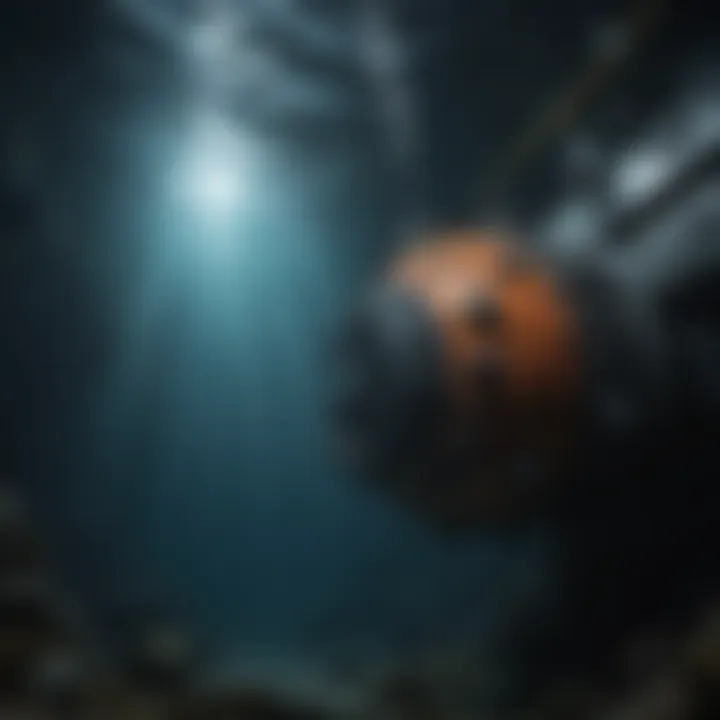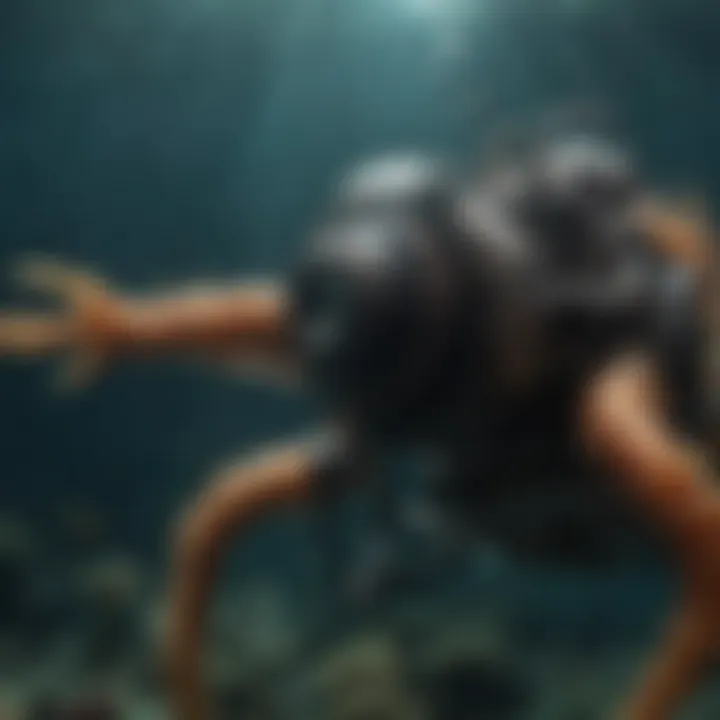Deep Sea Dives: Unraveling Ocean Mysteries


Intro
Deep sea diving offers an intriguing glimpse into the vastness of our planet's underwater domains. The ocean, covering about 71% of the Earth's surface, remains largely unexplored. Despite advances in technology, many aspects of deep-sea environments stay hidden, filled with uncertainties and awaiting discovery. This article focuses on the methodologies, findings, and ongoing research emphasizing the deep sea's ecological and geological significance.
Research Overview
In the pursuit of knowledge about the deep ocean, researchers have made some ground-breaking discoveries, enhancing our comprehension of marine ecosystems and geological formations.
Summary of Key Findings
Recent studies have revealed astonishing biodiversity in the deep sea. New species have been identified, showcasing how life thrives under extreme conditions. Ecological research has pointed towards complex food webs and the role of species in nutrient cycling. Additionally, geological surveys have unveiled underwater volcanoes and unique mineral formations that hold clues to the Earth's history.
- Biodiversity: New species discovered, including unusual deep-sea creatures with unique adaptations.
- Ecological Interactions: Understanding of food webs and nutrient cycling processes.
- Geological Insights: Identification of underwater volcanoes and interesting mineral formations.
Importance of the Research
The significance of deep sea research extends beyond mere exploration. It addresses pressing issues such as climate change, marine conservation, and potential resource extraction. By exploring deep-sea ecosystems, scientists can understand how these environments respond to external changes. Moreover, the deep ocean offers potential resources, including minerals and pharmaceuticals, prompting discussions about sustainable management and ethical considerations surrounding their extraction.
"Understanding the deep ocean is crucial for addressing climate change and preserving marine biodiversity."
Methodology
To gather data on deep sea environments, researchers employ various methodologies that ensure comprehensive insights.
Study Design
Studies typically involve expedition-based research using submersibles, remotely operated vehicles (ROVs), and autonomous underwater vehicles (AUVs). Through these means, researchers dive into depths that human divers cannot reach, obtaining valuable data on temperature, pressure, and species behavior.
Data Collection Techniques
Data is collected through various techniques such as:
- Visual Surveys: Observations of species behavior and community structures.
- Sampling: Collecting water and sediment samples to analyze chemical properties and organisms.
- Acoustic Monitoring: Using sound waves to map the ocean floor and detect biological activity.
With these methodologies, the scientific community continues to enhance its understanding of this enormous, complex environment, offering invaluable insights that inform not only research but also policy decisions related to ocean conservation and resource management.
Prelude to Deep Sea Dives
Deep sea dives represent a frontier of human exploration. Although over 70% of Earth’s surface is covered by water, the depth of the oceans remains largely uncharted. This section highlights the necessity of understanding our deep-sea environments, as well as the significance of research conducted in these remote areas.
One key aspect of deep sea diving is its potential to reveal unknown life forms. Organisms that exist in these depths often have unique adaptations suited to harsh conditions, which can lead to breakthroughs in biology and medicine. This research not only broadens our understanding of life on Earth but also informs ecological preservation efforts.
Moreover, scientific inquiry in deep oceanic regions contributes to our knowledge about climate change and its impact on marine ecosystems. Accessing these depths allows scientists to gather data that may be crucial for forecasting environmental shifts. Recognizing the deep sea's role in global climate systems can help in formulating policies for marine conservation.
In summary, diving into the depths of the ocean is more than an adventurous endeavor. It opens a window to countless discoveries that extend beyond marine biology, touching on environmental science, geology, and even technology.
Understanding the Deep Sea
The deep sea is generally defined as that part of the ocean below 200 meters. This zone is characterized by a range of conditions including high pressure, low temperatures, and complete darkness. The study of this environment can be complicated by these extreme factors, yet it is vital for understanding biodiversity.
Researchers have identified various ecological zones within the deep sea, each hosting unique communities. For example:
- Abyssal Plain: Flat or gently sloping areas of the deep sea floor located at depths of 3,000 to 6,000 meters.
- Hadopelagic Zone: The deepest layer, found in ocean trenches, reaching depths greater than 6,000 meters.
Both zones are home to species that have adapted to conditions of high pressure and low light. This specialization raises essential questions about the origins of life and adaptation in extreme conditions.
Historical Perspectives on Deep Sea Exploration
The exploration of the deep sea has come a long way since the earliest human attempts. Access to these depths required innovations in technology and a curiosity that has driven marine scientists for generations.
Early efforts, such as those by Captain James Cook in the late 18th century, focused mainly on mapping the oceans and understanding surface currents. The invention of the bathyscaphe in the mid-20th century revolutionized exploration, allowing humans to dive deeper than ever before. Notable dives, including those by Jacques Piccard and Don Walsh in the Trieste, opened up a new era of research.
As time went on, advancements in both submersibles and remotely operated vehicles (ROVs) have expanded our understanding of the deep sea. This history shows a blend of human ingenuity and relentless curiosity, setting the stage for future exploration.
In essence, the narrative of deep sea dives encompasses not just a journey into the oceans but a broader quest for knowledge about life on Earth.


Techniques for Deep Sea Diving
Understanding the techniques for deep sea diving is crucial for unlocking the mysteries of the ocean's depths. These methods not only ensure the safety of divers but also enhance the quality and extent of the research conducted in these extreme environments. By examining scuba diving, saturation diving, submersibles, and remotely operated vehicles (ROVs), we can appreciate the diverse options available for exploration beneath the surface. Each technique has specific benefits and considerations, directly impacting research outcomes and discoveries.
Scuba Diving vs. Saturation Diving
Scuba diving is the most well-known technique for underwater exploration. It allows divers to breathe compressed air through a tank. This method is ideal for shallower depths, generally less than 40 meters. Divers can quickly descend and ascend, making it suitable for research activities that require limited time underwater. However, a major limitation is the risk associated with nitrogen absorption, which can lead to decompression sickness if divers ascend too rapidly after deep dives.
On the other hand, saturation diving provides a different approach, designed for extreme depths and prolonged underwater stays. Divers live in a pressurized environment at sea and use a bell to reach the seabed. This technique significantly reduces the time divers spend in transit between the surface and the seabed, allowing for extended periods of exploration. It also minimizes the effects of nitrogen narcosis, as divers are saturated with gases continuously. However, the complexity and expense of saturation diving operations are considerable, limiting its use.
Submersibles and ROVs
Submersibles and remotely operated vehicles are integral to modern deep sea exploration. These technologies allow researchers to investigate regions previously deemed inaccessible, expanding our understanding of the ocean's secrets.
Types of Submersibles
Submersibles come in several types, each geared for specific missions. For instance, manned submersibles, like the Alvin, allow pilot and a small team to directly observe underwater environments. Their enclosed design protects occupants from the immense pressure found at great depths.
There are also unmanned submersibles, designed for autonomous exploration. These vehicles, such as the DeepSea Challenger, provide the ability to gather data and samples in hostile environments without risking human life. The key characteristic of submersibles is their ability to operate under extreme pressures, making them suitable for deep dives that surface methods cannot match. This feature enables scientists to study the geology and biology of the ocean floor directly. However, operational costs and maintenance needs can be high, and access can be limited based on location and condition.
Capabilities of Remote Operated Vehicles
Remote operated vehicles, known as ROVs, have revolutionized deep sea research. ROVs are tethered to a surface vessel, allowing operators to control them from a safe distance. This feature is particularly useful in hazardous environments and facilitates exploration tasks such as surveying, mapping, and sampling.
A major advantage of ROVs is their flexibility. They can be equipped with various tools, including cameras, robotic arms, and sensors, enabling researchers to conduct comprehensive surveys of underwater ecosystems. Additionally, ROVs are often more cost-effective than manned submersibles, which makes them a popular choice among research institutions. However, their reliance on surface vessels can limit operational range and depth compared to fully autonomous submersibles.
"The evolution of deep sea technologies marks a significant step in human understanding of the oceanic mysteries that cover over 70% of our planet's surface."
As deep sea exploration progresses, it is crucial to weigh the advantages and limitations of each diving technique. Whether using traditional scuba methods or high-tech submersibles and ROVs, each approach offers unique insights into the ocean's depths.
The Science of Deep Sea Ecosystems
Understanding deep sea ecosystems is crucial for numerous reasons. These ecosystems cover more than 60% of Earth's surface. They are not only vital for global biodiversity but also hold secrets about climate change and resource management. The deep sea teems with life that has adapted to extreme conditions, shedding light on fundamental biological processes. The ongoing research in these ecosystems ignites discussions on conservation and sustainable use of resources, making the science behind them ever more pertinent.
Biodiversity in Extreme Environments
Diversity within the deep sea offers insights into life's adaptability. Deep sea organisms range from bioluminescent creatures to those with unique physical structures.
Unique Adaptations of Deep Sea Organisms
Deep sea organisms exhibit adaptations that are remarkable. For instance, the anglerfish has developed a bioluminescent lure to attract prey in total darkness. This kind of adaptation is critical for survival in the harsh environments of the deep ocean. Moreover, many species have evolved specialized pressure-resistant proteins that allow them to function in extreme depths.
This characteristic of organisms is beneficial for understanding how life could exist in similar environments on other planets. These adaptations present advantages, such as enhanced survival, but may also come with disadvantages. For example, these species could be vulnerable to environmental changes because their adaptations are highly specific to their habitat.
The Role of Chemosynthesis
Chemosynthesis is a biological process that is fundamental in sustaining life in deep water, particularly around hydrothermal vents. Organisms here convert chemicals from the Earth's core into energy, bypassing the need for sunlight.
This process also highlights the adaptability of life. It is critical for nurturing unique communities that can thrive without solar energy. The key characteristic here is reliance on inorganic compounds, making it a beneficial area of study in understanding energy flows in ecosystems not reliant on photosynthesis. The unique feature of chemosynthesis ensures the survival of various extremophiles, organisms living in extreme conditions, taking advantage of the thermal and chemical resources.
Impact of Climate Change on Deep Sea Life
Climate change impacts the deep sea significantly. Temperature increases and ocean acidification threaten fragile ecosystems. Species adapted to specific temperature ranges may find themselves under stress, leading to population declines. Moreover, changes in ocean currents affect nutrient supply, altering food webs.
The ramifications are vast. Scientists observe shifts in species distribution and community structure. Understanding these changes is critical, as deep sea ecosystems play a role in global processes like carbon sequestration.
"Deep-sea ecosystems are essential for global biodiversity, yet they remain largely unexplored. Their study reveals vital information about our planet's health and future."
Geological Aspects of the Deep Ocean
The geological aspects of the deep ocean offer critical insights into not only the Earth's formation but also the ongoing processes that shape it. Understanding these elements reveals the dynamics at play beneath the ocean's surface. This exploration is essential for numerous reasons, including the potential for resource extraction, the effects of geological activity on ecosystems, and the implications for climate change. By studying the geological structures and processes in the deep sea, scientists can glean information about the past and anticipate future changes.
Seafloor Topography and Plate Tectonics
Seafloor topography is a fundamental aspect of geological studies in the ocean. It comprises the features and contours of the ocean floor, which can include mountains, valleys, ridges, and trenches. The patterns of these formations are largely influenced by plate tectonics, the movement of large slabs of Earth’s lithosphere.


- Mid-Ocean Ridges: These underwater mountain ranges are created by tectonic plates diverging, where magma rises to fill the gap. Areas like the Mid-Atlantic Ridge provide crucial information on the process of sea-floor spreading.
- Trenches: Deep-sea trenches, such as the Mariana Trench, serve as sites of subduction, where one tectonic plate moves under another. This results in significant geological activity and impacts marine life.
As researchers map these features, they can better understand pathways of ocean currents, sediment transport, and habitat availability for various marine species. These aspects further influence nutrient cycling and energy flow within ecosystems. Consequently, detailed knowledge of seafloor topography can aid in predicting the ecological impacts of human activities, such as deep-sea mining and carbon sequestration.
Hydrothermal Vents and Their Significance
Hydrothermal vents are among the most unique geological structures found in the deep sea. These fissures in the Earth’s surface release heated water rich in minerals. They create environments where life flourishes, independent of sunlight.
- Chemosynthesis: This process allows organisms like tube worms and certain bacteria to thrive, using chemicals from the vent fluids rather than sunlight for energy. This challenges traditional views of biological energy sources and expands our understanding of life’s adaptability.
- Mineral Deposits: Hydrothermal vents are hotspots for mineral deposition. This includes valuable resources like copper, gold, and zinc, leading to discussions about sustainable extraction methods and the balance between resource use and ecosystem health.
The study of hydrothermal vents also provides scientists with ways to understand extreme conditions on Earth and possibly other celestial bodies. Their relevance to astrobiology is significant, as they may offer clues about similar processes occurring in extraterrestrial environments.
By examining the geological aspects of the deep ocean, this section lays the groundwork for recognizing the interconnectedness of geological processes and marine ecosystems. As the debate about resource extraction continues, the need for a balanced approach to conservation and exploitation becomes increasingly paramount. Such discussions must consider not just the visible aspects of oceanic exploration but also the profound subtleties of geological influences in marine life.
Challenges and Risks in Deep Sea Diving
Deep sea diving, though a rewarding endeavor, comes with numerous challenges and risks that are crucial for divers and researchers to understand. These challenges are not merely inconveniences; they can significantly impact the success and safety of dives. Understanding these factors can lead to more informed decisions, better preparation, and ultimately safer explorations into the deep ocean.
In this section, we will explore two primary categories of risks: pressure-related hazards and health risks. Both categories encompass various elements that divers must take into account before embarking on their underwater journeys.
Pressure and Environmental Hazards
The pressure in deep-sea environments increases significantly with depth. For every 10 meters of water depth, pressure increases by approximately one atmosphere. This pressure can have detrimental effects on both divers and equipment.
- Effects on the human body: The human body is adapted to surface pressures. As divers descend, the exceeding pressure can lead to complications like barotrauma. Available airspaces in the body, such as the lungs, may expand, potentially leading to serious injuries if not managed properly.
- Equipment vulnerabilities: Diving gear must be specially designed to withstand extreme conditions. Standard equipment can fail when exposed to high pressure, resulting in dire consequences.
"Failure to use appropriate diving equipment at greater depths can lead directly to accidents and injuries."
In addition to pressure, the deep ocean is also fraught with environmental hazards such as cold temperatures, strong currents, and limited visibility. These conditions can lead to disorientation and fatigue, further complicating dive missions.
Health Risks for Deep Divers
Deep diving presents specific health risks that are worth considering. These risks, while well-documented , affect divers at any skilled level and merit careful attention.
Decompression Sickness
Decompression sickness, also known as 'the bends,' can occur when a diver ascends too quickly, causing nitrogen bubbles to form in the body. This is a key characteristic of decompression sickness that supports its relevance to this article. The rapid ascent traps nitrogen absorbed during the dive, resulting in potential tissue damage or even paralysis. Therefore, it is crucial to follow slow ascent procedures to avoid this condition.
Advantages of understanding decompression sickness include:
- Improved safety protocols.
- Enhanced dive planning.
- Better awareness of individual diving limits.
Decompression sickness necessitates careful ascent profiles. Many divers utilize decompression tables to manage their ascent, reducing the likelihood of this dangerous condition.
Psychological Factors
Deep diving does not only affect the body but can also impact psychological wellness. High-pressure environments and isolation present mental challenges for divers. Anxiety, stress, or panic can arise, leading to compromised decision-making and increased danger.
One notable characteristic of these psychological factors is their ability to undermine a diver’s focus, making it a significant consideration for this article. The potential for mental strain makes it essential for divers to maintain composure and minimize distractions.
Unique features of psychological risks include:
- Impacts on teamwork and communication underwater.
- The potential for sensory overload in complex environments.
Understanding the psychological aspects of deep sea diving can foster better training programs that prepare divers not only physically but also mentally for the challenges they may face below.
In summary, addressing challenges and risks in deep sea diving is not merely about acknowledging the dangers; it is about cultivating a comprehensive understanding of how those dangers can be mitigated through preparation and education. By doing so, we can enhance the safety of future deep sea explorations.
Recent Discoveries from Deep Sea Dives
The exploration of the deep ocean has yielded significant discoveries that deepen our understanding of marine ecosystems. Recent dives have provided insights into unique species and geological features. The complexities of the deep sea also pose challenges, making these discoveries vital for scientific progress.
New Species and Ecosystem Exploration
One of the most fascinating outcomes of deep sea dives is the identification of new marine species. These discoveries are essential as they reveal the diversity of life in extreme environments. For instance, researchers have discovered bioluminescent organisms that thrive in complete darkness at great depths. Understanding such life forms contributes to scientific knowledge about evolution and adaptation.


Studies have indicated that these new species play critical roles within their ecosystems. For example, many newly found creatures are involved in nutrient cycling, impacting the overall health of deep sea environments. By cataloging these organisms, scientists can find connections between different species and their habitats, contributing to a broader understanding of marine biodiversity.
Geological Findings and Resource Potential
The geological aspects of deep sea exploration also present significant findings that hold promise for future use. One area of growing interest is the study of mineral deposits.
Mineral Deposits
Mineral deposits found on the ocean floor are considerable for their potential economic value. These deposits often contain much-needed elements such as rare earth metals which are crucial for modern technology. The key characteristic of these deposits is their concentration and availability at depth.
These mineral deposits can be a beneficial choice for this article, highlighting the intersection of geology and resource management. However, harvesting these resources raises environmental concerns, making it imperative for researchers to carefully assess their impact on fragile ecosystems.
Unique features of these deposits include polymetallic nodules and hydrothermal vent mineralization. While they provide advantages in resource extraction, there are disadvantages related to environmental degradation and potential loss of biodiversity.
Potential for Renewable Energy
Another area of exploration in the context of deep sea dives is the potential for renewable energy. The deep ocean offers untapped energy resources like tidal and thermal energy. These energy sources can contribute significantly to global energy needs, lessening reliance on fossil fuels.
The key characteristic of potential renewable energy in deep sea lies in its sustainability. This makes it a popular choice for this article, given the urgency for cleaner energy solutions. Unique features include the ability to harness energy from underwater currents and temperature gradients.
However, despite these advantages, the challenges remain. These include the high cost of technology and the impact on marine life. Thus, while the potential is enticing, it must be approached with caution.
"The future of deep sea exploration is not only about discovering new species but also about understanding how we can utilize these resources without harming the environment."
The Future of Deep Sea Research
The future of deep sea research is a fascinating subject that holds great importance, as it increasingly shapes our understanding of the ocean's depths. As new technologies emerge, they offer researchers enhanced capabilities to explore previously inaccessible areas. This growth in equipment sophistication allows scientists to collect data on marine life, geological formations, and environmental changes with greater precision. Understanding these intricacies can help assess the health of ocean ecosystems and their response to human activities.
Advancements in technology play a pivotal role in carving out the future of deep sea exploration. For example, improved sensors and machine learning algorithms enable the analysis of vast ocean data, leading to more informed decisions regarding resource management and conservation. Additionally, the integration of autonomous underwater vehicles enhances the ability to conduct long-term studies without the need for human presence underwater, which reduces risks and increases research possibilities.
Moreover, deep sea research has significant implications for policy and conservation efforts. As awareness of environmental issues grows, the need for sustainable practices in ocean exploration becomes more apparent. This shift in focus demonstrates the critical need for a concerted effort from the scientific community, policymakers, and the public to ensure the protection of these fragile ecosystems.
Technological Advancements in Diving Equipment
Technological advancements in diving equipment are transforming the capabilities of researchers in the deep sea. Innovations such as improved submersibles, enhanced diving suits, and sophisticated diving instruments allow for deeper and longer dives. These new tools provide greater safety for divers and expand the scope of research activities. The use of real-time data transmission enables scientists to analyze information as it is collected, optimizing their responses to discoveries or potential hazards.
Furthermore, remote-operated vehicles (ROVs) equipped with advanced cameras and sensors have opened new frontiers in deep sea exploration. They can reach depths that human divers cannot safely access, making them invaluable to marine research. This innovation allows for detailed documentation of marine life and geological formations that were once beyond reach.
Policy and Conservation Efforts
The Role of International Treaties
International treaties play a crucial role in the future of deep sea research, especially concerning environmental protection and resource management. Agreements like the United Nations Convention on the Law of the Sea set guidelines for the exploration and use of ocean resources. These treaties ensure that countries cooperate to manage ocean resources responsibly, which is essential given the vast stretches of international waters that are often unregulated. The main characteristic of these treaties is their emphasis on sustainability and shared responsibility, making them a popular choice among stakeholders.
The unique feature of international treaties is their capacity to establish boundaries and protocols for deep sea exploration. While these agreements bring numerous advantages, such as collaboration and shared research, they also encounter challenges related to enforcement and compliance among different nations.
Community Engagement in Conservation
Community engagement in conservation is essential to fostering a sustainable future for deep sea research. By involving local populations and stakeholders in conservation efforts, researchers can leverage valuable indigenous knowledge and increase public awareness of the importance of the ocean. This participation helps create a more informed citizenry that can advocate for protective measures on local and global scales.
The key characteristic of community engagement is its potential to build trust and cooperation between scientists and the public. This element makes it a beneficial choice for promoting long-term conservation efforts. Engaging the community also allows for diverse input, which can enhance scientific research.
The unique feature of community involvement is its power to drive grassroots movements that support ocean conservation, yet there are disadvantages to consider. Achieving consensus among various groups can be challenging, and differing interests may complicate collaborative efforts. Overall, fostering community engagement is a vital component of the future of deep sea research, ensuring that exploration and conservation go hand in hand.
End
The exploration of deep sea dives is vital for understanding the complexities of our planet. As we conclude this article, it is essential to reflect on the specific elements that underscore the importance of this topic. First, deep sea dives provide a platform for significant scientific discoveries. They unveil new species and ecosystems that were previously unknown. Each dive holds the promise of shedding light on biodiversity and how life can thrive under extreme conditions.
Furthermore, this exploration contributes to geological understanding. The ocean floor is a tapestry of geological events, including volcanic activity and plate tectonics. By studying these areas, researchers can gain insights into Earth's history. The potential for resource extraction also presents economic opportunities that must be approached carefully due to environmental concerns.
Considerations about the future of deep sea exploration are particularly notable. As technology advances, the methods used for diving continue to evolve, making it safer and more effective. However, this comes with the responsibility to protect these vital ecosystems. International cooperation and local community engagement are key in conservation efforts.
Summarizing the Importance of Deep Sea Dives
Deep sea dives play a crucial role in enhancing our understanding of the planet's hidden depths. Several key areas highlight their importance:
- Biodiversity Insights: These dives reveal unique life forms and adaptations. Scientists can study organisms that have evolved to survive in extreme conditions. This knowledge is vital for understanding evolutionary biology.
- Geological Understanding: The ocean floor is rich in geological features. Studying these can help explain past tectonic movements and volcanic activity.
- Resource Potential: The deep ocean holds valuable resources such as minerals and potential sites for renewable energy. Responsible exploration can lead to sustainable practices.
- Climate Change Research: The impacts of climate change on deep sea ecosystems are becoming better understood through these dives. This information is crucial for broader environmental strategies.
- Technological Advancements: Developing and utilizing new technologies for diving sets the stage for future exploration. Machines such as remotely operated vehicles are leading the way in safe and thorough investigations.
"Deep sea exploration is not just about discovery, but also about responsibility. It challenges us to balance our thirst for knowledge with the need for preservation."
In summary, the importance of deep sea dives extends beyond mere exploration. They inform about ecological relationships, geological formations, and the potential for sustainable practices, all while emphasizing the need for conservation.



